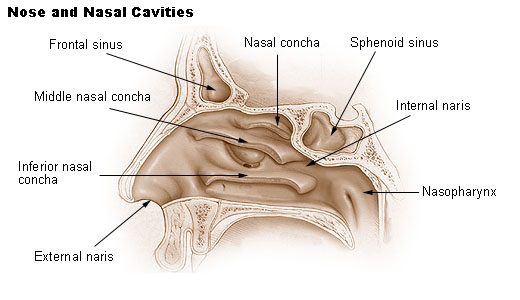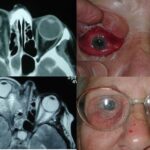Rhinorrhea, commonly known as a runny nose, is characterized by excessive nasal discharge. It may present as a watery, mucoid, or purulent fluid and can result from a wide variety of physiological and pathological processes. Rhinorrhea can be acute or chronic, unilateral or bilateral, and may be associated with other symptoms such as nasal congestion, sneezing, or postnasal drip. Accurate diagnosis and management depend on identifying the underlying cause.

Pathophysiology of Nasal Discharge
The nasal mucosa contains goblet cells and submucosal glands responsible for mucus production. Rhinorrhea occurs when this secretion increases due to irritation, inflammation, infection, or autonomic dysregulation. The drainage may be anterior (through the nostrils) or posterior (into the throat, leading to postnasal drip).
Common Causes of Rhinorrhea
1. Infectious Causes
- Viral Upper Respiratory Tract Infections (e.g., rhinovirus, coronavirus, influenza)
- Clear or mucoid nasal discharge, usually self-limited
- Bacterial Sinusitis
- Purulent discharge with facial pain and congestion
- COVID-19
- May present with clear rhinorrhea among other respiratory symptoms
2. Allergic Rhinitis
- Triggered by exposure to environmental allergens (pollen, dust mites, pet dander)
- Clear rhinorrhea, sneezing, nasal congestion, and pruritus
- Often seasonal or perennial in pattern
3. Nonallergic Rhinitis
- Includes vasomotor rhinitis, hormonal rhinitis, gustatory rhinitis
- Common in older adults and lacks an identifiable allergen
- Typically triggered by temperature changes, strong odors, or spicy food
4. Cerebrospinal Fluid (CSF) Leak
- Unilateral, clear, watery rhinorrhea
- Associated with trauma, surgery, or idiopathic causes
- Confirmed by presence of β2-transferrin in nasal fluid
5. Structural and Anatomic Causes
- Deviated nasal septum
- Nasal polyps
- Foreign body (especially in children with unilateral purulent discharge)
Clinical Presentation and Associated Symptoms
| Type | Nasal Discharge | Associated Features |
|---|---|---|
| Viral infection | Clear/mucoid | Fever, sore throat, cough |
| Bacterial sinusitis | Purulent | Facial pain, headache, prolonged symptoms |
| Allergic rhinitis | Clear, profuse | Sneezing, itching, bilateral involvement |
| Vasomotor rhinitis | Clear | Worsened by irritants like smoke or perfume |
| CSF rhinorrhea | Watery, unilateral | Positional headache, metallic taste |
Diagnostic Approach
History and Physical Examination
- Duration and onset of symptoms
- Presence of systemic signs (e.g., fever)
- Triggers and seasonal pattern
- Unilateral vs. bilateral discharge
Diagnostic Tests
- Nasal endoscopy: Evaluates nasal anatomy, polyps, or CSF leak
- Allergy testing: Identifies environmental allergens
- Beta-2 transferrin test: Confirms CSF leak
- CT/MRI scans: Assess structural abnormalities or sinus disease
Management and Treatment of Rhinorrhea
1. Symptomatic Treatment
- Nasal saline irrigation: Clears mucus and allergens
- Antihistamines: Effective for allergic rhinitis (e.g., loratadine, cetirizine)
- Intranasal corticosteroids: Reduce inflammation (e.g., fluticasone, mometasone)
2. Targeted Treatment Based on Etiology
- Viral Infections: Supportive care, hydration, rest
- Bacterial Sinusitis: Antibiotics like amoxicillin-clavulanate when indicated
- Allergic Rhinitis: Allergen avoidance, immunotherapy for persistent cases
- Nonallergic Rhinitis: Anticholinergic sprays (e.g., ipratropium bromide)
- CSF Leak: Neurosurgical repair required
Complications of Untreated Rhinorrhea
- Chronic sinusitis
- Eustachian tube dysfunction and middle ear infections
- Sleep disturbances and fatigue
- Social and occupational impairment
- Intracranial complications (in case of CSF rhinorrhea)
Preventive Measures and Lifestyle Modifications
- Avoid known allergens and environmental irritants
- Use air purifiers during high pollen seasons
- Practice hand hygiene to prevent viral infections
- Use protective gear in workplaces with chemical exposure
- Avoid overuse of nasal decongestant sprays to prevent rhinitis medicamentosa
Prognosis and Long-Term Outlook
The prognosis for rhinorrhea largely depends on the underlying cause. Most cases related to viral infections or allergies respond well to appropriate treatment. Chronic cases or those associated with structural or neurologic issues may require surgical intervention or long-term management.
When to Refer to a Specialist
Referral to an otolaryngologist or allergist is warranted in the following cases:
- Recurrent or chronic rhinorrhea unresponsive to initial treatment
- Suspicion of nasal polyps or tumors
- Unilateral, persistent watery discharge (possible CSF leak)
- Need for allergy immunotherapy or desensitization
Rhinorrhea is a multifactorial symptom with a broad differential diagnosis. Accurate identification of the cause—whether infectious, allergic, structural, or cerebrospinal—is essential for effective management. A systematic approach combining clinical evaluation with targeted investigations ensures optimal patient outcomes. We emphasize early recognition of red flags such as unilateral clear discharge or persistent symptoms to avoid potentially serious complications.

